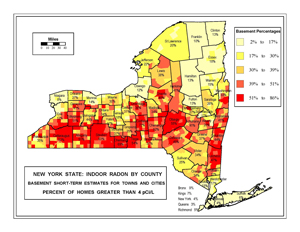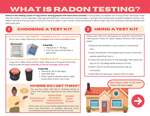Environmental Exposure to Radon
Environmental Exposure to Radon
Radon is a natural colorless, odorless gas that is released when uranium in bedrock decays. Radon is the leading cause of lung cancer in people who have never smoked and is the second leading cause of lung cancer overall. The main route of exposure to radon is inhalation in indoor spaces. Radon can enter buildings through cracks in the foundation. Other lesser sources of radon include building materials such as concrete, brick, stone, or granite countertops and groundwater. The only way to know if your home has radon is to test.
 Diagram of how radon enters a building through the cracks in the foundation and moves upwards through the building.
Diagram of how radon enters a building through the cracks in the foundation and moves upwards through the building.
 Some areas in New York have higher levels of radon than others because of differences in bedrock. This New York State Department of Health map shows the percent of homes tested. Homes with radon levels above 4 pCi/L. The EPA recommends taking action to mitigate radon if your home's levels are between 2 pCi/L and 4 pCi/L.
Some areas in New York have higher levels of radon than others because of differences in bedrock. This New York State Department of Health map shows the percent of homes tested. Homes with radon levels above 4 pCi/L. The EPA recommends taking action to mitigate radon if your home's levels are between 2 pCi/L and 4 pCi/L.
What are we doing
The IHHE (Institute for Human Health and the Environment) and the Wilmot Cancer Institute's Community Outreach and Engagement team are working together to increase community outreach to encourage people to test their homes for radon. We created this infographic to explain the different kinds of tests, costs, and mitigation approaches.
Where to learn more
- New York State Department of Health: Radon
- Center for Disease Control and Prevention: Radon
- Environmental Protection Agency: Radon
- US Department of Housing and Urban Development: Radon Explainer Videos
- American Lung Association: Radon
